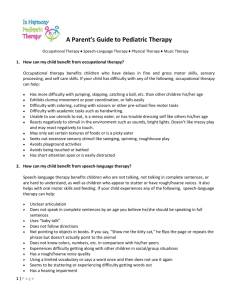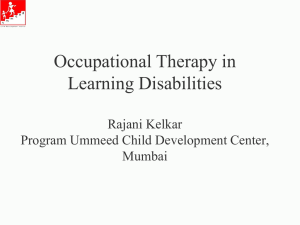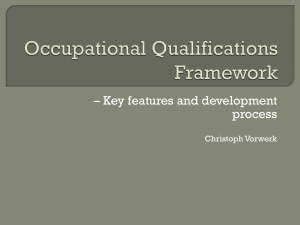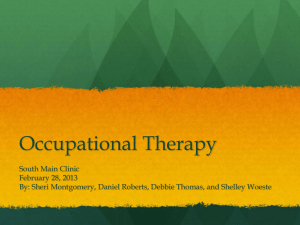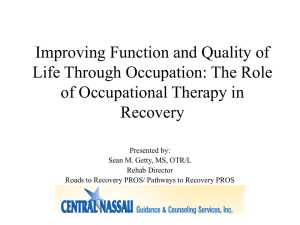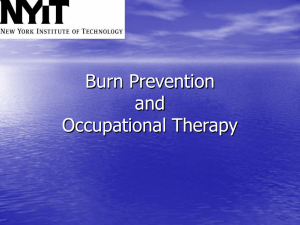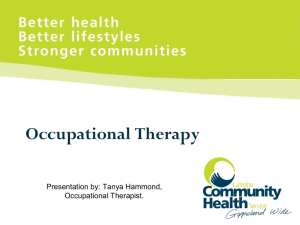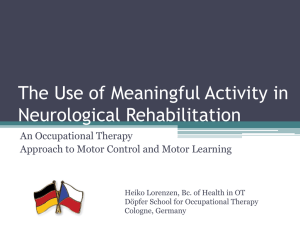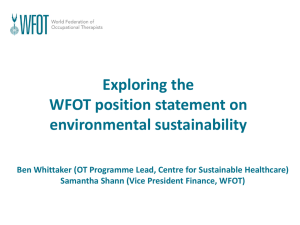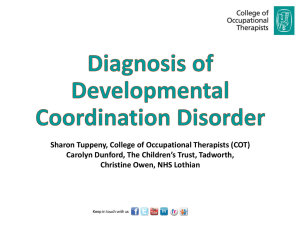Occupational Therapy (Click to download)
advertisement
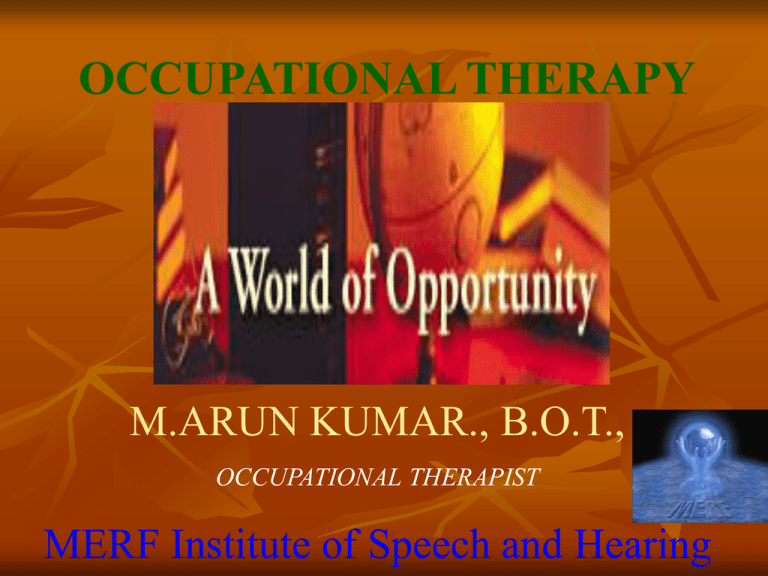
OCCUPATIONAL THERAPY M.ARUN KUMAR., B.O.T., OCCUPATIONAL THERAPIST MERF Institute of Speech and Hearing Take a moment to think of some of the things (occupations) you have done today... have you had a shower, had lunch with friends, or gone to work? HOW WOULD YOU… HAVE A SHOWER IF… You had poor balance? You couldn’t reach your arms up to your hair? HOW WOULD YOU… HAVE LUNCH WITH FRIENDS IF… You couldn’t hold a fork? You couldn’t remember where to meet them? You just couldn’t cope with getting out of bed? HOW WOULD YOU… GO TO WORK IF… You had pain in your back? You heard voices in your head? You had arthritis in your hands? OCCUPATIONAL THERAPY Is the assessment and treatment of physical and psychiatric conditions, using specific purposeful activity to prevent disability and promote independent function in all aspect of daily life. Who do Occupational Therapists work with? Children Seniors Adolescents Adults Where do Occupational Therapists work? Hospitals Schools Mental Health Facilities Home Care Personal Care Homes Private Clinics Rehabilitation Centers Community Health Centers Insurance Companies Client Homes Client Work Places Occupational Therapists are concerned with: Person, Environment Occupation Interactions OP HUMANS AS OCCUPATIONAL BEINGS – PEOP MODEL Social Support Physiological Cognitive PERSON (Intrinsic Factors) Spiritual Neurobehavioral Psychological WELL BEING OCCUPATION Occupational Performance & Participation PERFORMANCE Social & Economic Systems ENVIRONMENT (Extrinsic Factors) Culture & Values Built Environments & Technology Natural Environments QUALITY OF LIFE OCCUPATIONAL THERAPY SERVICES FOR INFANTS AND CHILDREN Pediatric occupational therapy is skilled treatment aimed to enable the child to be as physically psychologically and socially independent as possible. HOW DO THEY WORK Occupational therapists works in close partnership with…. Medical Team Educational Team Community Team Family Together they have a shared responsibility for meeting children’s needs. MULTIPLE DISABILITY When child has several different disabilities we say, that He/She has multiple disability Multiplication of disability 50% cerebral palsy – visual deficit 13% cerebral palsy – auditory deficit Mental retardation SOME EXAMPLES OF MULTIPLE DISABILITIES ARE: Deafblind (Visual impairment + hearing impairment) Visual impairment + hearing impairment + mental retardation. Visual impairment + mental retardation. Cerebral palsy + mental retardation / hearing / speech / visual problems. Hearing / Listening Vision / Looking Touch Smell Taste Movement Sensory integration Cognitive Social GROSS MOTOR SKILLS: Movement of the large muscles in the arms, and legs. Abilities like Rolling Crawling Walking Running Jumping Hopping Skipping FINE MOTOR SKILLS: Movement and dexterity of the small muscles in the hand and fingers. Abilities like In-hand manipulation Reaching Carrying Shifting small objects SENSORY INTEGRATION Sensory processing Ability like Vestibular Proprioceptive Tactile Visual Auditory Gustatory Olfactory skills CENTRAL NERVOUS SYSTEM COGNITIVE PERCEPTUAL SKILLS: Abilities like Attention Concentration Memory Thinking Reasoning Problem solving Concept of shape Size and color VISUAL MOTOR SKILLS: Perception of visual information Abilities like copying MOTOR PLANNING SKILLS: Ability to Plan Implement Sequence motor tasks. ORAL MOTOR SKILLS: Movement of muscles in the Mouth Lips Tongue Jaw Sucking Biting Chewing Blowing Licking PLAY SKILLS: Age appropriate purposeful play skills SOCIO-EMOTIONAL SKILLS: Ability to interact with peers and others. ACTIVITIES OF DAILY LIVING: Self – care skills like daily Dressing Feeding Bathing Grooming Toilet tasks ENVIRONMENT MANIPULATION Like handling Switches Door knobs Phones TV remote HUMANS AS OCCUPATIONAL BEINGS – PEOP MODEL Social Support Physiological Cognitive CHILD (Intrinsic Factors) Spiritual Neurobehavioral Psychological WELL BEING OCCUPATION Occupational Performance & Participation PERFORMANCE Social & Economic Systems ENVIRONMENT (Extrinsic Factors) Culture & Values Built Environments & Technology Natural Environments QUALITY OF LIFE Case Example Profoundly deaf, identified at 11 months Developmental history of hypotonia, tactile defensiveness, motor overflow, poor eye contact. Slow learning rate, limited social interaction with peers Referred by preschool teacher On observation Reduced proprioceptive perception Weak bilateral coordination and motor planning Reduce proximal trunk stability Avoidance of crossing midline Therapy Implementation Successive approximation based on motor complexity Increase visual and perceptual skill Model matching side by side Facilitate midline crossing Guidance and support of motor plan Influence of sensory integration procedures on language development. Ayres AJ, Mailloux Z. Am J Occup Ther. 1981 Jun;35(6):383-90 The relationship between language development and sensory integration was explored through single case experimental studies of one female and three male aphasic children ranging in age from 4 years, 0 months to 5 years, 3 months. Three of the four children had received either speech therapy, special education specific to aphasia, or both, before starting occupational therapy. Inspection of rate of language growth before and after starting occupational therapy showed a consistent increase in rate of growth in language comprehensive concomitant with occupational therapy compared to previous growth rate. Thank you Comments and Questions?
